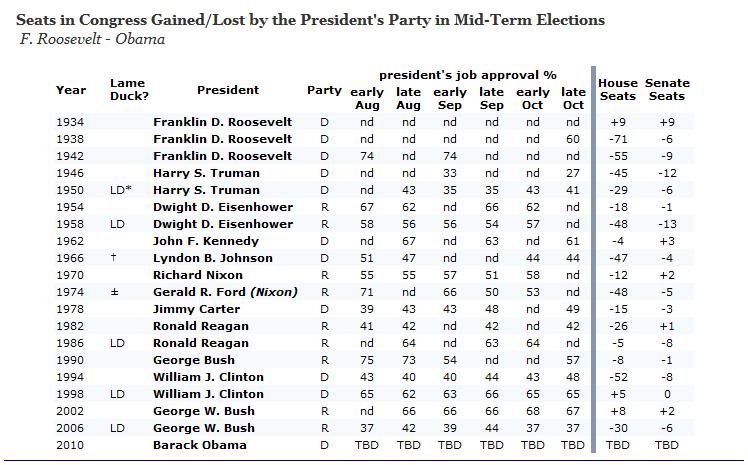By Robert Kuttner
Politics is the art of the possible, but also the art of leadership. President Roosevelt’s Democratic Party gained seats in Congress in 1934, the first mid-term election after Roosevelt took office, despite unemployment exceeding 15 percent. Ordinary Americans knew Roosevelt was on their side.
And rather than seeking illusory common ground with Republicans or with Wall Street, Roosevelt was eloquent in naming and shaming his opposition.
<...>
Why isn’t Obama behaving more like Harry Truman in 1948? Truman pulled off one of the great upsets of American political history, winning his own election and flipping 75 House seats from Republican to Democrat.
Even though Republicans, who controlled Congress in 1948, were certain to block his program, Truman sent Congress the legislation he wanted and dared Republicans to vote it down — rather than starting with half a loaf, ending with crumbs, and blurring differences.
moreWhen it comes to President Obama, people sure love to rewrite history.
Social Security was not the
perfect bill, and it had the support of
16 Republicans.
The FDIC was established as a temporary agency with few powers.
- Banking Act of 1933 (P.L. 73-66, 48 STAT. 162).
Also known as the Glass-Steagall Act. Established the FDIC as a temporary agency. Separated commercial banking from investment banking, establishing them as separate lines of commerce.
- Banking Act of 1935 (P.L. 74-305, 49 STAT. 684).
Established the FDIC as a permanent agency of the government.
- Federal Deposit Insurance Act of 1950 (P.L. 81-797, 64 STAT. 873).
Revised and consolidated earlier FDIC legislation into one Act. Embodied the basic authority for the operation of the FDIC.
- Bank Holding Company Act of 1956 (P.L. 84-511, 70 STAT. 133).
Required Federal Reserve Board approval for the establishment of a bank holding company. Prohibited bank holding companies headquartered in one state from acquiring a bank in another state.
linkFDR evolved.
The U.S. Deposit Insurance System
The first national deposit insurance system in the world was the FDIC. It was created in 1933 during the Great Depression to restore public confidence in the U.S. financial system and to protect small depositors. At the time of its creation, the U.S. was in the midst of the largest financial crisis in its history. During the first few months of 1933, 4,000 U.S. banks suspended operations. Bank runs had become commonplace and President Roosevelt was forced to impose a national banking holiday. The issue of the moment was how to restore confidence in the banking system.
When the FDIC was created, there was no national system of deposit insurance in the world. President Roosevelt actually opposed its creation, even threatened to veto the legislation that was to create the FDIC. He was concerned about the moral hazard that can occur when protection extended to depositors makes them less diligent in the selection and monitoring of their banks, and makes banks less careful in their lending practices. Banking industry groups also opposed the FDIC's creation because they were concerned about the premiums their members might have to pay.
But the American public demanded a system of deposit insurance that would provide a safe place for people to put their money. The public had experienced widespread bank runs and did not want to have that experience again. Broad public support overcame the obstacles to the creation of the FDIC.
Without a doubt, the FDIC helped restore public confidence in the U.S. financial system. In 1934, the year after the FDIC was created, only nine banks failed compared to 4,000 bank closures during the nine months prior to its creation. Deposit insurance effectively ended bank runs in the U.S. The FDIC is widely viewed as one of the most successful legacies of that era, and remains highly relevant to the challenges facing the U.S. financial system today.
linkIn 1948, Truman was up for re-election, it was not a mid-term.
 link
linkAlso, fighting losing battles only leads to bitter disappointments.
<...>
By mid-1951 the AMA was openly claiming victory, and President Truman acknowledged as much when he omitted the proposal from his 1952 state of the Union message. Instead, he announced the establishment of a Commission on the Health Needs of the Nation to study the problem. In the presidential election that year, the Democratic candidate, Adlai E. Stevenson (who replaced the retiring President as the party's standard bearer, skirted the issue of Government health insurance. On the other hand, the winner, Dwight D. Eisenhower, voiced strong opposition to the proposal, ensuring that the new administration would not soon revive it.
In sum, the Wagner-Murray-Dingell bill was the victim of a cautious Congress, massive resistance by a prestigious and vitally affected interest group, sympathy for the AMA's position from an imposing array of nonmedical groups, a lack of wholehearted support from some of the key proponents, considerable antipathy from the press, the rapid growth of private insurance, and, finally, of a hostile political climate. (12)
Years later, President Truman wrote: "I have had some bitter disappointments as President, but the one that has troubled me most, in a personal way, has been the failure to defeat the organized opposition to a National compulsory health insurance program. But this opposition has only delayed and cannot stop the adoption of an indispensable Federal health insurance plan."
linkPresident Obama will have no such regret on health care reform.